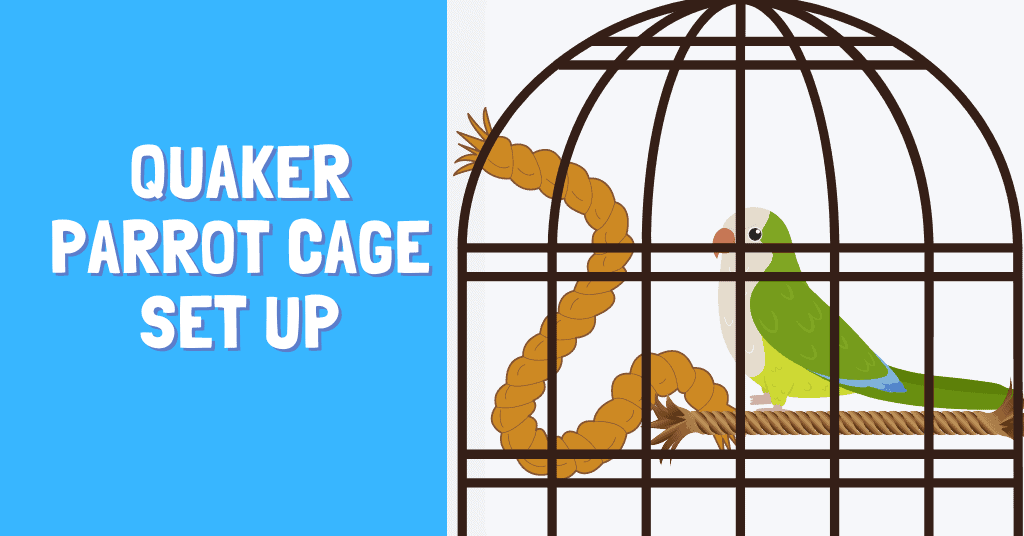A Quaker parrot is an intelligent, social and playful companion. They need plenty of stimulation to stay happy and healthy. That’s why it’s important to set up their home with the right environment for them to thrive in.
This guide will help you get started on setting up your new Quaker parrot cage! You’ll learn all about what goes into a proper setup, how much space they need, what type of food they eat, and more!
Quaker parrots are a lot of things, but the most important thing you need to take into consideration when setting up their cage is the activity level and the fact they need more than 1 bird to stay happy in a cage.
As social animals, these birds love to climb, play and chew. Also, Quaker parrots can live anywhere from 25-40 years (depending on the research).
This means you really need to set up the cage for a long lifetime.
But don’t worry – I’ve got a guide below that will teach you exactly what you need to know when setting your Quaker parrot up with a cage! Let’s get started…

Quaker Parrot Cage Size & Space Requirements
Because these are active birds that require ample room to roam around multiple levels of their home, space is very important when choosing out a new cage for your Quaker bird.
While many people often believe bigger is better for a pet bird, many cages found in shops today are too small. This is especially true when it comes to Quaker parrots.
Birdcages need a minimum of 24″ x 32″ x 24″ for one lone bird or 32″ x 32″ x 32″ (or longer) for two birds. These measurements are appropriate for Dwarf and Normal species of Quakers, but if you own an Eclectus then you may have to get a larger cage.
The reason these dimensions are important are that they allow the bird enough room to play around on multiple levels, climb and fly around safely, move freely throughout the cage without bumping into everything.
Even better if you set up an outdoor heated aviary for your Quaker to fly around in. This will give them even more room and is a must for flying birds like Quakers!
Quaker Parrot Cage Bar Spacing & Size: I cannot stress this enough – do not buy a cage with bars that are too close together!
There have been many recalls on cages over the years, especially when it comes to small bird cages, due to the fact they hurt the animals as they can get their head stuck between the wires or even break bones trying to escape their cage.
While you might think having smaller bar spacing is better, believe me when I say 3/4″ spacing should be plenty of space for any new Quaker parrot owner. Yes these birds are smart and can get out of a cage with 1″ spacing, but the smaller spacing can cause health problems and even lead to death.
So keep this in mind when selecting a new cage that has wider bar spacing for your bird (and any other pet you may have).
Special note:
When choosing an enclosure for your quaker, make sure it gives them a comfortable space with their safety needs and enough security. Snap-shut doors are more dangerous for your bird as he might get hurt by accident. The safer choice is a door that opens sideways.

Quaker Parrot Cage Flooring
Quaker parrots are known to chew their way through anything they see fit, so it’s important to not only use a sturdy flooring material but also one that is suitable for chewing.
Many owners prefer using either black or white roosting paper or both – especially if you have multiple birds. This will save you money on replacing the same spot all the time! This stuff is cheap and easy to apply too. Just cut out the right size and press in place. Easy!
I like using paper roosting for a number of reasons:
It’s cheap to replace if they chew through it (a lot cheaper than replacing sections of wooden flooring) It makes clean up quick and easy It adds some fun “texture” to the bottom of the cage – as well as something new to explore! It’s also more forgiving on bird claws while climbing.
You can also use solid metal or wood too if you really wanted, but I would stay away from any material that has a rough texture or tends to collect feces.

Positioning of the cage
Quaker parrots should be placed in a room that is quiet but still gets lots of food traffic. If you have a busy household or lots of children running around, it is best to place the cage away from all that or at least in an area where noise won’t disturb your bird too much.
Quaker parrots are social birds and love being with their owners. So if possible, try placing them in a room where they can see and hear you most of the time. This will encourage them to keep close to you when out of the cage, on top of feeling more secure knowing you’re nearby.
Another thing worth mentioning is that Quakers tend to be loud during certain times throughout the day (usually early morning). They do this by shaking objects within the cage as well as making other noises such as chirping.
So it’s good to keep that in mind when deciding where you want to place your cage.
The cage should get some natural sunlight and moonlight as well. It’s great for their colors and overall health.

Cage Interior & Setup
This is your birds home and it should be decorated like a home. Your bird will spend a lot of time in here, so it should feel comfortable and safe.
There are a lot of different ways to go about setting up your cage – you can decorate with perches, toys, hammocks, etc. What you put in the cage is up to you and what your bird likes best!
Don’t skip on the toys, Quakers get board easily. You should have mirrors and perches and rope bridges and plants and all sorts of things that will keep your bird entertained and active.
And obviously toys and decorations aside, You will need nesting boxes if you intend on breeding your parrots, and food and water dishes. There’s a variety you can choose from.
Below you will find a list of some great toys for Quakers that I absolutely love, these are tried and true favorites!

Why You Need Toys For Your Parrot!
Your bird needs toys – it’s as simple as that. Just like any other animal or child, they need stimulation to keep them happy and healthy both physically and mentally.
If you give them nothing fun to look at or do all day, your quaker can develop depression over time which leads to many health problems (usually relating to things like obesity). So make sure the cage always has something new and exciting in it.

Maintaining The Cage Once Your All Set Up
- Replace Paper
- Remove Used Food/Water Dishes and refresh them
- Clean up any Messes on the Floor
- Change Light Bulbs
- Clean the poop tray
- Remove and replace broken toys or worn-out ropes
Maintenance is one of the most important aspects of owning a pet, just like with any other.
The more you take care of your cage and bird, the longer they will be able to live their happy life inside it! The absolute best thing you can do for them is to keep cleaning and changing things out in order to prevent any boredom from setting in and to keep illness away.
While some owners don’t worry about this – I feel it’s well worth the extra effort knowing that all my birds are growing up happy and healthy because of it.



